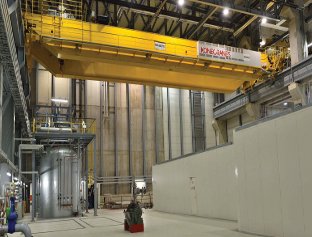Power up
23 August 2018On-shore energy generation such as coalfired power stations and hydro-electric dams each have their own demands from their lifting equipment. Julian Champkin looks at three case studies.
Grosskraftwerk Mannheim AG (GKM) produces power and heating for the Rhine-Neckar metropolitan region. Its Unit 9, which was connected to the grid in 2015, is one of the world’s most efficient coal-fired power plants. It is a large plant, with complex processes within it. For example: each year, about 3m tons of hard coal are fed into the boilers. It needs to be unloaded by the loading bridges, stored, and transported by conveyor systems to the four power plant units at the site, to arrive at exactly the right time.
For all these transport, maintenance and lifting tasks GKM uses no fewer than 260 crane systems and hoists. They range from simple chain pulleys to the 300t powerhouse crane and come from various manufacturers and have different years of construction and histories of service.
It is an enormous fleet, and each one of the 260 units requires maintenance and safety-related checks on a yearly basis. For this huge undertaking GKM uses software supplied by Konecranes. A cloudbased portal co-ordinates the service requirements of all these cranes, regardless of the type of crane or its manufacturer.
Timing of the maintenance of each machine is important to reduce overall disruption to a minimum. At the beginning of each year, experts from Konecranes working with GKM coordinate the timeframes for these and for safety-related checks. In planning the service schedules the operational processes are monitored in detail, and an optimal date for maintenance is set. On the portal any operative at GKM can always track the service dates for any machine; he can also use the portal to put in online requests for servicing and spares. Konecranes service technicians spend approximately three months at GKM performing maintenance and check-ups.
The engineers always have mobile access to all information—from technical data to test reports—on their smartphone or tablet, regardless of where they are located within the large premises of the plant.
With every check-up the technicians create a test report, update the units’ data on the portal, and advise how further to optimise the unit, and GKM can track the status of each item immediately in the service calendar. A search function can sort the units by criteria such as maintenance priority, last actions or newly requested services. Responsible departments receive notifications in a quick and uncomplicated manner, and repair orders can be initiated promptly.
The system gives both an overview and data on individual cranes. Thus GKM always has its 260 units in view online and the maintenance process becomes more efficient
